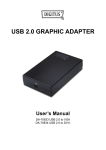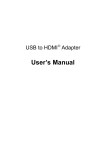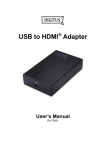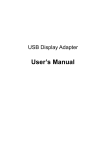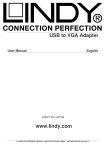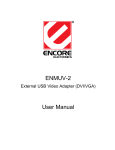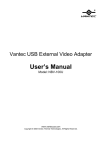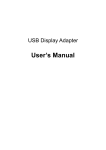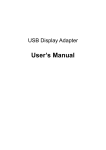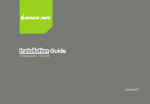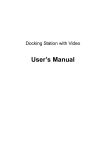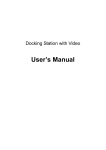Download Goodway AN2460
Transcript
USB Display Adapter User’s Manual USB Display Adapter User’s Manual ABOUT THIS MANUAL This manual is designed for use with the USB Display Adapter. Information in this document has been carefully checked for accuracy; however, no guarantee is given to the correctness of the contents. The information in this document is subject to change without notice. The manufacturer does not make any representations or warranties (implied or otherwise) regarding the accuracy and completeness of this document and shall in no event be liable for any loss of profit or any commercial damage, including but not limited to special, incidental, consequential, or other damage. SAFETY INSTRUCTIONS Always read the safety instructions carefully: Keep this User’s Manual for future reference Keep this equipment away from humidity If any of the following situation arises, get the equipment checked by a service technician: The equipment has been exposed to moisture. The equipment has been dropped and damaged. The equipment has obvious sign of breakage. The equipment has not been working well or you cannot get it to work according to the User’s Manual. COPYRIGHT This document contains proprietary information protected by copyright. All right are reserved. No part of this manual may be reproduced by any mechanical, electronic or other means, in any form, without prior written permission of the manufacturer. i Table of Contents Table of Contents 1. Introduction .......................................................................................................1 Applications ........................................................................................................2 Features..............................................................................................................2 Package Contents...............................................................................................3 System Requirements.........................................................................................3 2. Installation .........................................................................................................5 On Windows 2000/ XP/ Vista ..............................................................................5 On Windows 7 ....................................................................................................8 Connected to the adapter and monitor..............................................................12 3. Using the Adapter ...........................................................................................14 Display Properties.............................................................................................14 Display Modes ..................................................................................................15 Extend Your Windows Desktop to Add-on Monitor (Default)......................15 Mirror Your Windows Desktop ...................................................................18 Be the Primary Monitor ..............................................................................20 Adjusting Resolution, Color Depth and Refresh Rate .......................................21 Configure the components.........................................................................22 Standby and Hibernate, Shut Down and Restart...............................................25 Disconnecting the Adapter ................................................................................25 Using Dual Adapters .........................................................................................25 Verifying the Driver Installation..........................................................................27 Uninstall the Adapter and Driver .......................................................................28 4. Troubleshooting ..............................................................................................29 5. Specifications..................................................................................................31 6. Regulatory Compliance ..................................................................................33 FCC Conditions ................................................................................................33 CE.....................................................................................................................33 WEEE Information ............................................................................................33 ii 1. Introduction 1. Introduction This USB Display Adapter enables you to connect one more monitor, LCD or projector to a computer with a USB 2.0 port. For desktop users adding an extra monitor via USB connection is easier than ever without having to open the computer chassis to install an internal video card. Once the installation is done, the USB-attached monitor soon wakes up. No function key hassle to swap a second monitor. With this handy adapter, you can enjoy many benefits brought by an add-on monitor. The most obvious one is that you get more desktop area to have more applications visible at one time. For example, you may work on one monitor while your family watching video on the other. No more stacking windows within the confines of a single display. Or you may span an application, e.g. spreadsheets, across two sides of displays. What’s more, the adapter is hot pluggable. If you are not using the extra monitor, just unplug the adapter at any time; no reboot needed. System performance is an important issue when using multiple monitors. Another benefit of this adapter is that it uses little computer resource; ensuring users get quality display without comprising computer performance. VGA or DVI monitor USB-enabled computer 1 USB Display Adapter User’s Manual Applications Office workstation View your large spreadsheets across two screens with display continuity Multitask more effectively without overlapping windows Edit on one screen while surfing the Internet information on the other On the road Do multiple screen presentations without bringing another computer Easily provide multiple screen exhibitions in a trade show Graphics workstation Use second display for palettes/tools Get a panoramic view of large documents Editing workstation Type documents on one screen while viewing reference material on the other Compare two documents simultaneously across two screens Financial analysis Have one monitor per data stream View charts and live data at the same time Entertainment View videos/TV on one screen and reviews on the other Get additional perspectives when playing games Features Add-on monitor, LCD or projector through a single USB 2.0 port Hot-plug ; add or remove monitor without system reboot Small in size, works with all VGA / DVI-I displays. Supports High Resolution up to 1920x1080 Video streaming is supported up to 1080p Extend and Mirror mode support. Resumes from hibernation and suspend modes Supports up to 6 USB display adapters to work simultaneously 2 1. Introduction Package Contents Before installation, please check the items in the package. The package should contain the following items: USB Display Adapter x1 Driver CD x1 USB Cable x1 Quick Installation Guide x1 DVI to VGA Adapter (Optional) x1 System Requirements The minimum requirements for the PC are: With Single Core CPU at 1.2GHz or higher processor clock. Intel Pentium/Celeron family, or AMD K6/Athlon/Duron family, or compatible processor 512MB memory At least one USB2.0 port 30Mb of available disk space Windows 2000 SP 4, XP Home or Professional (Including Table edition) SP2 or SP3, Vista SP1 (32-bit or 64-bit) and Windows 7 (32-bit or 64-bit). Super VGA (800 x 600) or higher resolution monitor To play DVD on the adapter-attached monitor, in addition to the requirements above, the following requirements should also be met: With dual core CPU at 2.0 GHz processor clock The adapter screen resolution be set to 800x600 with 16bit color 3 USB Display Adapter User’s Manual In addition to the following processor and memory configurations (base on usage model) For 1-2 monitors, business usage, productivity target. This may not provide full frame rate DVD playback at full screen. 1.2GHz Single Core CPU 512MB memory For 3 monitors, where 1 could run DVD video while also targeting productivity and business apps. Will support only 1 video of DVD resolution at full screen:. 1.8GHz CPU 1GB memory For 6 screen where 1 screen can run full screen DVD video: 1.6GHz Core Duo 1GB memory 4 2. Installation 2. Installation On Windows 2000 /XP/ Vista Caution: DO NOT connect the USB display adapter to your computer before you install the provided driver. You will be instructed to do so later. Follow the procedures below to install the driver and then connect the adapter: 1. Insert the provided CD into your disc drive. Please locate and double-click the Run Setup.exe file under x:\Driver where x is your disc drive letter. You may see the License agreement screen prompted as below. Please click on I Accept to start the Driver install. Note: If the installer program doesn’t run automatically, please locate and double-click on the Autorun.exe file in the CD to launch the install program. If you encounter a User Account Control dialog box when attempting to install a program, enter an administrator password or click Allow to start the installation. 5 USB Display Adapter User’s Manual 2. Please wait while Windows configures DisplayLink Core Software. Your screens may temporarily go black or flash during this process. *Actual strings depend on your operation system. These screen shots are from Windows XP and might vary slightly for each operation system. Notice for Windows Vista/2000 users: If prompted to restart your computer, click Yes to restart or No to manually restart later. Note that a reboot is always needed for a successful installation. If the reboot prompt doesn’t appear, make sure to manually reboot your computer. 3. When finished, the installation screen will disappear and you will return to your desktop. 4. Connect the USB display adapter to your computer and monitor. Connect the smaller end of the USB cable to the adapter. Then connect the other end of the USB cable to an USB 2.0 port on your computer. 6 2. Installation 5. After the installation is completed, you will see the DisplayLink Manager Icon in System Tray that looks like a monitor as below. Click on the icon to bring up the menu. -Extend Mode: The screen is part of the extended desktop. -Mirror Mode: The screen copies the contents of the primary screen. -Off Mode: The screen is black. -Set as Main Monitor: The screen is the primary screen. -Notebook monitor off: The Notebook screen is black and the DisplayLink screen is the primary screen. 7 USB Display Adapter User’s Manual On Windows 7 Caution: DO NOT connect the USB display adapter to your computer before you install the provided driver. You will be instructed to do so later. Follow the procedures below to install the driver and then connect the adapter: 1. Insert the provided CD into your disc drive and installer program will run automatically when the Driver CD is inserted. Please click on Run Setup.exe to execute the installer program. Note: If the installer program doesn’t run automatically, please locate and double-click on the Setup.exe file in the Driver folder to launch the setup program. If you encounter a User Account Control dialog box when attempting to install a program, enter an administrator password or click Allow to start the installation. 8 2. Installation 2. When you see the License Agreement screen prompted as below, please click on I Accept to install the software for USB display adapter... 3. Please wait while Windows configures DisplayLink Core Software. Your screens may temporarily go black or flash during this process. 9 USB Display Adapter User’s Manual 4. When finished, the installation screen will disappear and you will return to your desktop. 5. Connect the USB display adapter to your computer and monitor. Connect the smaller end of the USB cable to the adapter. Then connect the other end of the USB cable to an USB 2.0 port on your computer. 6. After the installation is completed, the following Window will pop up. You can change the appearance of your displays through the Window. Moreover, additional controls are available in Windows 7: Orientation (Portrait, landscape, rotated portrait, rotated landscape) 10 2. Installation 7. To control the behavior of an attached DisplayLink device (or screen), it is possible to use Windows Key+P to display a menu (and cycle through it) to allow: Disconnect Projector, Duplicate, Extend, Projector Only. *Actual strings depend on your operation system. These screen shots are from Windows 7 and might vary slightly for each operation system. *Actual strings depend on your operation system. These screen shots are from Windows Vista 32-bit and might vary slightly for each operation system. 11 USB Display Adapter User’s Manual Connected to the adapter and monitor If your monitor is not yet connected to the adapter, make the connection and power on your monitor. For VGA model: Use a VGA cable (not provided) to connect the VGA jack to a monitor equipped with VGA input jack. For DVI model: The equipped DVI-I (DVI-Integrated) connector transmits both the digital and analog signals. This means it supports either of these two connection types: It can be connected to a DVI-D (digital) monitor using a DVI cable (not provided) Or, it can be connected to an analog VGA monitor using the provided DVI-I to VGA adapter and a VGA cable (not provided). 12 2. Installation ◆After you connect the adapter, Windows will automatically complete the installation. ◆Once the installation is done, an extended screen will appear on the add-on monitor. For Windows Vista, if the add-on monitor is blank, please reboot your system again. If required, you can connect and disconnect the add-on monitor any time without disconnecting the adapter from the USB port on your computer. To change the display mode, see next chapter for instructions. During the installation, it’s normal that the screen flicks black a couple of times. Sometimes it takes time for the add-on monitor to show the video. 13 USB Display Adapter User’s Manual 3. Using the Adapter Display Properties Display Properties allows you to configuration the display mode, color quality, screen resolution, and physical arrangement of your monitors. *The USB display adapter Display mode and adjusting Resolution, Color Depth and Refresh Rate. Please refer to the “Display mode” and Adjusting Resolution, Color Depth and Refresh Rate “” section for details. Easy Setting Click on the DisplayLink Device icon and select Advanced to configuration Display Properties as above or manually setting as below description. On Windows 7, the DisplayLink Device icon will be hided. Please click the arrow sign and right click the DisplayLink Device icon to select Advanced. Manually Setting Position the mouse anywhere on your computer desktop, right-click and select Screen Resolution on Win 7, Personalize > Display Settings on Vista or Properties > Settings on XP/2000. 14 3. Using the Adapter Display Modes There is several ways you can utilize the monitor attached on the adapter. The add-on monitor can be configured to use either “mirror mode”, “extended mode” or be the primary display as described in this section. Extend Your Windows Desktop to Add-on Monitor (Default) In this so-called “extended mode”, your display will be spread over the add-on monitor(s). This mode allows you to perform multiple tasks more effectively without overlapping windows. Easy Setting Click on the DisplayLink Device icon and select Exchange or Extend to Right; Left; Above; Below to configuration the setting as above, or manually setting as below description. 15 USB Display Adapter User’s Manual Notice: The full DisplayLink User Interface as above is not supported on Windows 7. Displays Configuration on Windows 7 should be carried out using the improved Windows Display Properties dialog box (figure1), and using the Windows-P key combination (figure2). Figure 1 Figure 2 Manually Setting Extended mode is the default setting. To set up the adapter to use or restore extended mode, follow these steps: 1. Position the mouse anywhere on your computer desktop, right-click and select Screen Resolution on Win 7, Personalize > Display Settings on Vista or Properties > Settings on XP/2000. 2. In the Display drop-down menu, select the option with the string “DisplayLink Graphics Adapter”. 3. Check the Multiple Displays> Extend these displays on Win 7, Extend the desktop onto this monitor box on Vista or Extend my Windows desktop onto this 16 3. Using the Adapter monitor box on XP/2000. 4. Drag the icons in the window at the top of the screen to match the physical arrangement of your primary monitor and add-on monitor. The add-on monitor connected to the adapter may be identified as either "2" or “3”, depending on your computer, although there may not be a total of 3 screens connected. 5. Click OK to close the settings screen. c. a. b. Once the setting is done, to use your extended desktop, simply drag and drop your open windows over to your second monitor. However, note that some applications may not support display on the extended desktop. Cursor disappeared ? If you’re in extneded mode but the add-on monitor is not connected, the desktop still pans to the add-on monitor and it’s possible that your cursor has moved to the extended desktop so that you cannot find it on the primary display. To solve the problem in such a case, connect the add-on monitor to the adapter or keep moving your mouse to try or unplug the adapter first to restore the cursor. 17 USB Display Adapter User’s Manual Video and DVD Playback in Extened Mode On Windows Vista with extended mode, it’s suggested that you run video or DVD playback programs on your primary monitor instead of the add-on monitor to ensure the playback performance. Mirror Your Windows Desktop This mode is referred to as “mirror” or “clone” mode. In this mode, your original screen (the primary display) will be mirrored to the add-on monitor. Easy Setting Click on the DisplayLink Device icon and select Mirror to configuration the setting as above, or manually setting as below description. 18 3. Using the Adapter Notice: The full DisplayLink User Interface as above is not supported on Windows 7. Displays Configuration on Windows 7 should be carried out using the improved Windows Display Properties dialog box (figure1), and using the Windows-P key combination (figure2). Figure 1 Figure 2 Manually Setting In mirror mode, the adapter will automatically select the settings (screen resolution, color quality and refresh rate) for the add-on monitor. But you can manually adjust the settings as required. However, the settings of the add-on monitor are limited by that of the primary monitor. For example, even though your add-on monitor supports a resolution of up to 1920x1080, you can only configure it to use 1280x1024 due to the primary monitor only supports a resolution of up to 1280x1024. 19 USB Display Adapter User’s Manual If you change the video output to extended mode and then want to switch back to mirror mode, follow these steps: 1. Position the mouse anywhere on your computer desktop, right-click and select Screen Resolution on Win 7, Personalize > Display Settings on Vista or Properties > Settings on XP/2000. 2. In the Display drop-down menu, select the option with the string “DisplayLink Graphics Adapter”. 3. Check the Multiple Displays> Duplicate these displays on Win 7, uncheck the Extend the desktop onto this monitor on Vista or Extend my Windows desktop onto this monitor on XP/2000. 4. Click OK to close the settings screen Be the Primary Monitor To make the add-on monitor the primary display: 1. Position the mouse anywhere on your computer desktop, right-click and select Screen Resolution on Win 7, Personalize > Display Settings on Vista or Properties > Settings on XP/2000. 2. In the Display drop-down menu, select the option ends with DisplayLink Graphics Adapter. 3. Check the This is my main monitor box on Vista/Win 7 or Use this device as the primary monitor box on XP/2000. On some PCs and laptops it is necessary to disable the main display (i.e. uncheck the Extend the desktop onto this monitor or Extend my Windows desktop onto this monitor box for the main display) as part of the same settings change. 4. Click OK to close the settings screen. The add-on monitor stays primary if the PC enters hibernate or suspend mode or is rebooted. If the add-on monitor is unplugged, the main display becomes primary again. 20 3. Using the Adapter Adjusting Resolution, Color Depth and Refresh Rate There are three components that make up the screen mode: Resolution: In common usage, this refers to the number of pixels displayed on screen horizontally and vertically. Color Depth: This defines the number of different colors that can be shown on the screen at the same time. Refresh rate: Measures the speed that the entire screen is rescanned. Higher frequencies reduce flicker. Some monitors advertise the supported modes through the video connector. If this is the case, the adapter identifies the supported modes from the monitor. If the monitor does not advertise the supported modes, the adapter software chooses a set of common screen modes for the monitor. The software supports the modes listed below. Color Depth Refresh rates Refresh rates available at 16 bit available at 32 bit color quality color quality 60 72 75 85 60 72 75 85 56 60 72 75 85 56 60 72 75 85 XGA 60 70 75 85 60 70 75 85 720p 60 60 WXGA+ 60 75 85 60 75 85 WXGA 60 60 SXGA 60 75 85 60 75 WXGA+ 60 60 SXGA+ 60 75 85 60 75 85 UXGA 60 60 WSXGA+ 60 60 1080p 60 60 Name Resolution 640x480 800x600 1024x768 1280x720 1280x768 1280x800 1280x1024 1366x768 1400x1050 1600x1200 1680x1050 1920x1080 VGA SVGA *Note that interlaced modes and reduced blanking modes are not supported. 21 USB Display Adapter User’s Manual About the resolutions and refresh rates available to users The resolutions and refresh rates available to the user through Windows are a comprise of the support from the following elements: ■ The USB display adapter ■ The primary monitor and the add-on monitor ■ The primary video card on your computer and installed drivers Therefore, for example, if your monitor doesn’t support a resolution of 1920x1080, then 1920x1080 is not possible even you are using a USB display adapter with 1920x1080 support. This ensures that the monitor cannot be put into an unsupported mode, which might damage it. If cloning the primary display, the video component will try to use the preferred monitor mode. In some cases, this may not be the most appropriate mode for the cloned desktop. It is recommended that the primary display resolution be changed to closer match the default resolution of the add-on monitor. Configure the components To configure the three components (resolution, color depth and refresh rate) of a screen mode, follow these steps: Easy Setting Click on the DisplayLink Device icon and select Color Quality; Screen Rotation ; Screen Resolution to configuration the setting as above, or manually setting as below description. Color Quality :There are two kinds of color quality, the Medium (16-bit) and the Highest (32-bit). 22 3. Using the Adapter Screen Rotation :There are four kinds of screen rotation, the Normal, Rotated Left, Rotated Right and Upside-Down. Screen Resolution:The resolution will be depends on your computer setting, resolution support of moniter and else…. Manually Setting 1. Position the mouse anywhere on your computer desktop, right-click and select Screen Resolution on Win 7, Personalize > Display Settings on Vista or Properties > Settings on XP/2000. 2. In the Display drop-down menu, select the option ends with DisplayLink Graphics Adapter. 3. To change the screen resolution or color quality, select those options on the screen. Be sure to select one of the supported resolutions and color quality numbers in the table above. For an add-on monitor, you can also select any resolution or color quality supported by that monitor. 23 USB Display Adapter User’s Manual 4. To change the refresh rate, click Advanced… and then click Monitor. 5. Select a refresh rate from the Screen refresh rate drop-down list and then click Apply. 6. Click OK to close the settings screen. 24 3. Using the Adapter Standby and Hibernate, Shut Down and Restart When the adapter is connected to a computer and an external monitor, if the computer goes into standby or hibernate mode, the external monitor display goes blank. When the computer returns to an active state, the external monitor display keeps the same settings it had before the computer went into standby or hibernate mode. However, if the add-on monitor was set for extended mode, windows that were previously on the external monitor will not move back to that secondary monitor. Also, if the add-on monitor is in extended mode and the computer requires a login after standby or hibernate mode, the login screen appears on the primary computer monitor, not the external monitor. If the computer is shut down, restarted and logged in, again the add-on monitor returns to the same mode as it was before shutdown. Disconnecting the Adapter If the adapter is unplugged from the computer, the add-on monitor goes blank. All windows and icons move to the primary screen. On reconnection of the adapter, the adapter returns to the same mode as it was before disconnection. However, windows and icons that were previously on the screen will not be moved back. Using Dual Adapters Up to two adapters can be simultaneously attached to one computer. To use two adapters: 1. Install the driver as described in the “2. Installation” section and connect the first adapter to your computer. 2. Then connect the second adapter to your computer. The system will automatically complete the installation. While two adapters are connected to a computer, in most cases both adapters supports extended and mirror modes. The only exception is on Windows Vista XDDM mode as described below. 25 USB Display Adapter User’s Manual Limitation for dual adapters on Windows Vista in XDDM mode: In this mode one extended screen and one mirrored screen is supported. Only the first connected adapter can be configured to use extended mode; the second adapter is forced to use mirror mode. When you bring out the Windows display settings dialog box, you will find that only one …DisplayLink Graphics Adapter (representing your first attached adapter) is configurable. What is Vista XDDM mode? XDDM refers to Windows XP Driver Mode. It is a video card driver mode used in some legacy computers that running the new generation Vista OS. It provides an interface similar to Windows XP user Interface on Vista and one of its characteristics is that it doesn’t support Windows Aero interface. To see current display video driver mode, right-click Computer on the desktop and select Device Manager. Then expand the Display adapters item. 26 3. Using the Adapter Verifying the Driver Installation To verify your USB display adapter driver installation, please launch Device Manager by the steps below: Open the Control Panel and double-click Uninstall a Program on Win 7, Programs and Features on Vista, and Add or Remove Programs on XP/2000. *Actual strings depend on your operation system. These screen shots are from Windows Vista 32-bit and might vary slightly for each operation system. A string similar to DisplayLink Core Software and DisplayLink Graphics should be displayed. If there is a question or exclamation mark next to that item, then the driver is not properly installed. Please delete the item, unplug the adapter and repeat the installation steps. 27 USB Display Adapter User’s Manual Uninstall the Adapter and Driver If for any reason you want to uninstall the video adapter and its driver, please take these steps: 1. Open the Control Panel and double-click Uninstall a Program on Win 7, Programs and Features on Vista, and Add or Remove Programs on XP/2000. 2. Select DisplayLink Graphics or DispalyLink Core Software and click Uninstall or Remove. 3. Click Yes to confirm the removal. During the removal process a couple of DOS windows will pop up. 4. Click Yes to restart your computer and then unplug the adapter now. 28 4. Troubleshooting 4. Troubleshooting Q1: The display on the add-on monitor is blank. A: If the monitor power LED is green (in most cases), wait a moment for the monitor to show the video as sometimes it takes time for the add-on monitor to show the video. You can also reboot your system to try again. Also make sure the computer is not in standby or hibernation mode, which will lead the add-on monitor to be blank. If the monitor power LED is red (in most cases), check if the connection is properly made. If problem still exists, uninstall the driver, unplug the adapter and reinstall the driver to try again. Q2: The add-on monitor is flickering. A: This is usually caused by a low refresh rate. To solve this problem: In mirror mode, increase the refresh rate of the main monitor. This will in turn increase the refresh rate of the add-on monitor. In extended mode, increase the refresh rate of the add-on monitor. Q3: When I play MPEG file by Windows Media Player on the extended monitor, how come the display becomes abnormal when I switch it to full screen mode? A: If your system is Windows XP SP1, we suggest you upgrade it to SP2 to solve this problem. 29 USB Display Adapter User’s Manual Q4: When playing the video in full screen mode, the motion is not smooth. A: Try the following tips to improve the smoothness of the movie playback: Reduce the resolution of the display to 640x480 or 800x600. Use the adapter in extended mode. Terminate any other CPU intensive applications running on the computer. If you still have issues playing media content on the adapter, try the following steps: As some media players require DirectX hardware support to correctly operate, try a different media player which requires less DirectX support. Drag the media player to the add-on screen and close the player. Restart the player and it should open on the add-on monitor. Now try playing the media file again. Try reducing the hardware acceleration level of the primary display (NOT the add-on monitor) to levels 1,2 or 3 and restarting the media player. The hardware acceleration can be found by right-clicking on your desktop and click Properties > Settings > Advanced > Troubleshoot. Some players use this setting even when playing on a different display. The video playback may be unusual when the add-on monitor is mirroring the primary display and there is another extended screen connected to the computer. The extended screen must be disabled before the content will be correctly cloned to the add-on monitor. Q5: In extended mode, the add-on monitor appears to have a black border around the desktop. A: This happens when the resolution used by the add-on monitor is larger than the resolution used by the primary monitor. To solve this problem, configure the add-on monitor to use the same resolution as the primary monitor. 30 5. Specifications 5. Specifications Host Interface USB 2.0 Video Interface VGA or DVI-I Connectors Video output: VGA HDDE 15pin Female Connector or DVI HDDE 29pin Female Connector Host upstream link: USB Mini-B Type Female Connector Connectivity Up to 6 adapters on a computer RAM 8M x 16 DDR Synchronous DRAM (SDRAM) Power Mode Bus-powered Power Consumption 430mA Operation System Support Windows 2000 SP 4 , XP Home or Professional (Including Table edition) SP2 or SP3, Vista SP1 (32-bit or 64-bit) and Windows 7 (32-bit or 64-bit). Supported Modes Extended Desktop (Default), Mirrored Desktop, Primary Display 31 USB Display Adapter User’s Manual Resolutions, Refresh rate and color depth Color Depth Name Resolution 640x480 VGA 800x600 SVGA 1024x768 Refresh rates Refresh rates at 16 bit color quality at 32 bit color quality 60 72 75 85 60 72 75 85 56 60 72 75 85 56 60 72 75 85 XGA 60 70 75 85 60 70 75 85 1280x720 720p 60 60 1280x768 WXGA+ 60 75 85 60 75 85 1280x800 WXGA 60 60 1280x1024 SXGA 60 75 85 60 75 1366x768 WXGA+ 60 60 1400x1050 SXGA+ 60 75 85 60 75 85 1600x1200 UXGA 60 60 WSXGA+ 60 60 1680x1050 1920x1080 1080p 60 60 *Note that interlaced modes and reduced blanking modes are not supported. Housing ABS Plastic Dimensions 84.5 (L) x 55.5 (W) x18 (H) mm USB Cable Separated from the body Type: USB A -Type Male to 5pin Mini USB B-Type Male Length: 1M Operating temperature 10-40 degree Storage temperature -10~80degree Relative Humidity < 85% non-condensing * Specifications are subject to change without notice. 32 6. Regulatory Compliance 6. Regulatory Compliance FCC Conditions This equipment has been tested and found to comply with Part 15 of the FCC Rules. Operation is subject to the following two conditions: (1) This device may not cause harmful interference (2) This device must accept any interference received. Including interference that may cause undesired operation. Important! Changes or modifications not expressly approved by the manufacturer responsible for compliance could void the user’s authority to operate the equipment. Use an approved phone set. CE This equipment is in compliance with the requirements of the following regulations: EN 55 022: CLASS B WEEE Information For EU (European Union) member users: According to the WEEE (Waste electrical and electronic equipment) Directive, do not dispose of this product as household waste or commercial waste. Waste electrical and electronic equipment should be appropriately collected and recycled as required by practices established for your country. For information on recycling of this product, please contact your local authorities, your household waste disposal service or the shop where you purchased the product. 33




































